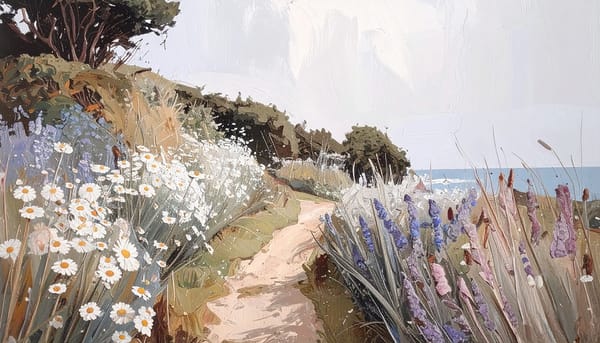In a Cornish garden shaped by wind, rain, and sun, resilience isn’t just a desirable trait — it’s essential. And increasingly, resilience isn’t just about withstanding nature but working in harmony with it. This means creating garden spaces that not only survive but thrive, nurturing biodiversity and helping mitigate the effects of climate change.
Rethinking Lawns: The Rise of Tapestry Planting
The traditional British lawn — closely mown, heavily fertilised, and often chemically treated — has become a symbol of unsustainable gardening. In contrast, the tapestry lawn is a vibrant patchwork of low-growing plants, blending native wildflowers, creeping herbs, and drought-tolerant groundcovers.
These living tapestries support pollinators, reduce the need for mowing, and bring texture, colour, and scent to spaces usually dominated by monoculture grass. Species such as clover, self-heal, creeping thyme, and chamomile provide a carpet that shifts with the seasons while holding up to foot traffic and Cornish weather.
Unlike a conventional lawn, a tapestry lawn is alive with bees, butterflies, and even ground beetles — transforming passive green space into active habitat.
Rain Gardens: Harnessing Water, Naturally
In a county where storms roll in from the Atlantic and sudden downpours are part of the seasonal rhythm, managing water in the garden is both a practical and ecological concern. Rain gardens — shallow, planted depressions designed to capture and slowly absorb rainwater — offer a beautiful solution.
By channelling runoff from roofs, patios, or driveways into rain gardens, gardeners help prevent flooding and soil erosion while replenishing groundwater. The planting choices matter: species that can handle both temporary inundation and dry spells — like marsh marigold, purple loosestrife, flag iris, and sedges — create rain gardens that are as ornamental as they are functional.
In Cornwall’s coastal and sloping landscapes, rain gardens work particularly well when combined with swales or planted embankments, softening hard edges and encouraging natural drainage patterns.
Connecting Landscapes: The Power of Wildlife Corridors
Biodiversity doesn’t exist in isolation — and neither should gardens. Wildlife corridors are the invisible highways that allow animals, birds, and insects to move between habitats, find food, and breed.
In a fragmented landscape, even a small hedgerow, flower border, or wilder patch can become a vital link. For Cornish gardeners, this might mean planting native hedging like hawthorn, blackthorn, or hazel, leaving boundary fences partially open for hedgehog movement, or connecting garden ponds with wildflower strips.
When multiple gardens within a community adopt this approach, the result is a patchwork of connected spaces where wildlife can flourish. In coastal villages or hamlets bordered by farmland, these corridors become essential lifelines for pollinators, birds, and small mammals.
A Garden Philosophy Rooted in Place
Tapestry lawns, rain gardens, and wildlife corridors aren’t standalone trends — they are interconnected elements of a gardening philosophy grounded in observation, care, and a deep respect for Cornwall’s unique landscape.
They invite us to step back from rigid control and instead design with the land, responding to its contours, climate, and living networks. In doing so, we create not only gardens that are rich in beauty and biodiversity but also spaces that contribute — however quietly — to the resilience of the wider Cornish environment.








